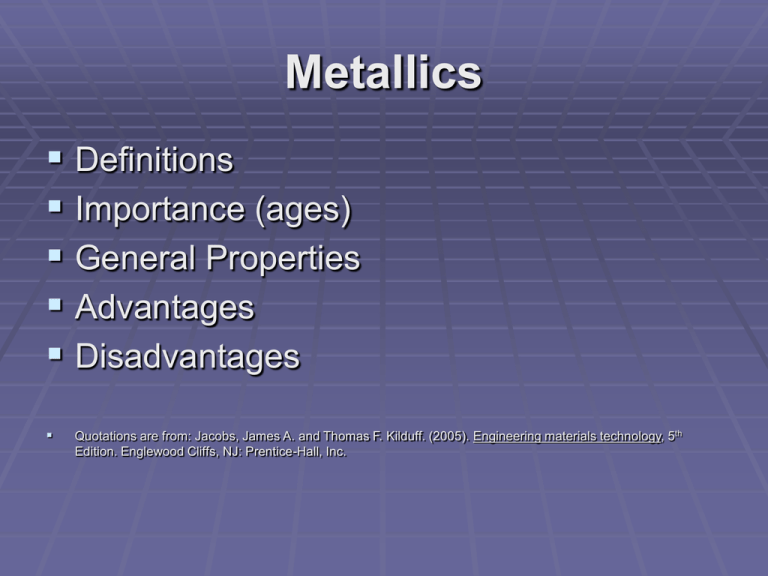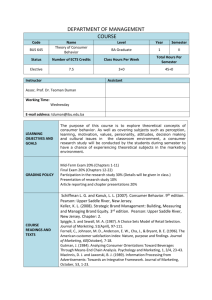
Metallics
Definitions
Importance (ages)
General Properties
Advantages
Disadvantages
Quotations are from: Jacobs, James A. and Thomas F. Kilduff. (2005). Engineering materials technology, 5th
Edition. Englewood Cliffs, NJ: Prentice-Hall, Inc.
Types
Base metal
elements
e.g., copper, aluminum, zinc, mercury
Alloy
combinations
e.g., steel, bronze, brass, solder
Types
Ferrous
contains iron
ferromagnetic
e.g., wrought iron, steel, cast iron
Non-ferrous
does not contain iron
e.g., aluminum, brass, nickel
Crystalline structure
work hardening
hot rolling vs. cold rolling
recrystallization temperature
FIGURE 5-4
James A. Jacobs & Thomas F. Kilduff
Engineering Materials Technology, Fourth
Edition
Some work-hardening (cold-working) processes.
Copyright ©2001 by Prentice-Hall, Inc.
Upper Saddle River, New Jersey 07458
All rights reserved.
FIGURE 5-4
James A. Jacobs & Thomas F. Kilduff
Engineering Materials Technology, Fourth
Edition
Some work-hardening (cold-working) processes.
Copyright ©2001 by Prentice-Hall, Inc.
Upper Saddle River, New Jersey 07458
All rights reserved.
Phase
“a homogeneous part or aggregation of
material that differs from another part due
to difference in structure, composition, or
both”
Iron’s crystal lattices
body-centered cubic
face-center cubic
phases Alpha: α
Gamma: γ
Delta: δ
(capturing carbon)
(grains in metals)
FIGURE 3-54
James A. Jacobs & Thomas F. Kilduff
Engineering Materials Technology, Fourth
Edition
Allotropic forms of iron (three phases: bcc, fcc, bcc).
Copyright ©2001 by Prentice-Hall, Inc.
Upper Saddle River, New Jersey 07458
All rights reserved.
FIGURE 3-23
James A. Jacobs & Thomas F. Kilduff
Engineering Materials Technology, Fourth
Edition
A body-centered cubic unit cell.
Copyright ©2001 by Prentice-Hall, Inc.
Upper Saddle River, New Jersey 07458
All rights reserved.
FIGURE 3-24
James A. Jacobs & Thomas F. Kilduff
Engineering Materials Technology, Fourth
Edition
A face-centered cubic unit cell.
Copyright ©2001 by Prentice-Hall, Inc.
Upper Saddle River, New Jersey 07458
All rights reserved.
FIGURE 3-25
James A. Jacobs & Thomas F. Kilduff
Engineering Materials Technology, Fourth
Edition
A body-centered tetragonal crystal lattice unit cell.
Copyright ©2001 by Prentice-Hall, Inc.
Upper Saddle River, New Jersey 07458
All rights reserved.
FIGURE 3-26
(a) A hexagonal crystal lattice unit cell. (b) Top plane of unit cell showing six equilateral triangles
James A. Jacobs & Thomas F. Kilduff
Engineering Materials Technology, Fourth
Edition
Copyright ©2001 by Prentice-Hall, Inc.
Upper Saddle River, New Jersey 07458
All rights reserved.
James A. Jacobs & Thomas F. Kilduff
Engineering Materials Technology, Fourth
Edition
Copyright ©2001 by Prentice-Hall, Inc.
Upper Saddle River, New Jersey 07458
All rights reserved.
FIGURE 3-54
James A. Jacobs & Thomas F. Kilduff
Engineering Materials Technology, Fourth
Edition
Allotropic forms of iron (three phases: bcc, fcc, bcc).
Copyright ©2001 by Prentice-Hall, Inc.
Upper Saddle River, New Jersey 07458
All rights reserved.
FIGURE 5-5
(a) Simplified iron-carbon equilibrium diagram. (United State Steel Corporation)
James A. Jacobs & Thomas F. Kilduff
Engineering Materials Technology, Fourth
Edition
Copyright ©2001 by Prentice-Hall, Inc.
Upper Saddle River, New Jersey 07458
All rights reserved.
FIGURE 3-1 Stages of a metal cooling through equilibrium: first nucleates, then forms dendrites, and finally cools into a
crystalline solid of many metal grains.
James A. Jacobs & Thomas F. Kilduff
Engineering Materials Technology, Fourth
Edition
Copyright ©2001 by Prentice-Hall, Inc.
Upper Saddle River, New Jersey 07458
All rights reserved.
Hardening metallics
hardenable vs. non-hardenable
getting carbon into steel
homogenous
surface only (case-hardening)
heat treating
chemical treatments
mechanical (work hardening)
Typical heat treating
Annealing
Quenching
Tempering
FIGURE 5-22
(b) Hardenability plot of hardness (Rockwell C-scale) versus distance from quenched end of specimen.
James A. Jacobs & Thomas F. Kilduff
Engineering Materials Technology, Fourth
Edition
Copyright ©2001 by Prentice-Hall, Inc.
Upper Saddle River, New Jersey 07458
All rights reserved.
Ferrous metallics
Contain a large proportion of iron (Fe).
Magnets attract iron.
Iron rusts or oxidizes.
Ferrous materials usually spark when
ground.
Trends
Adding Carbon to Iron
1% carbon = 100 points
solid solutions
super-saturation
phases and heat treating
Iron and Iron-Carbon Alloys
Wrought iron: 0 to 0.000 8% carbon.
Carbon Steel: .0008 to 2.0 % carbon.
Low Carbon Steel: less than 0.30 % carbon.
Medium Carbon Steel: 0.30 to 0.60 % carbon.
High Carbon Steel: 0.60 to 1.50 (2) % carbon.
Cast iron: 2.0 to 4.0 or 5.0 % carbon.
FIGURE 5-30 Gray cast iron. (a) The low-magnification photomicrograph at left illustrates the graphite distribution, type, and
size. At 1000x (at right), the pearlite colonies and small ferrite grains adjacent to the graphite flakes are clearly distinguishable.
The large, round gray particles are manganese-sulfide inclusions. The surface of the specimen contains products of
transformation of a faster cooling rate. (Buehler Ltd.)
James A. Jacobs & Thomas F. Kilduff
Engineering Materials Technology, Fourth
Edition
Copyright ©2001 by Prentice-Hall, Inc.
Upper Saddle River, New Jersey 07458
All rights reserved.
FIGURE 3-36
A face plane of an fcc unit cell for iron showing a carbon atom located in an interstice
James A. Jacobs & Thomas F. Kilduff
Engineering Materials Technology, Fourth
Edition
Copyright ©2001 by Prentice-Hall, Inc.
Upper Saddle River, New Jersey 07458
All rights reserved.
James A. Jacobs & Thomas F. Kilduff
Engineering Materials Technology, Fourth
Edition
Copyright ©2001 by Prentice-Hall, Inc.
Upper Saddle River, New Jersey 07458
All rights reserved.
FIGURE 5-33
James A. Jacobs & Thomas F. Kilduff
Engineering Materials Technology, Fourth
Edition
(a) SAE-AISI steel designation.
Copyright ©2001 by Prentice-Hall, Inc.
Upper Saddle River, New Jersey 07458
All rights reserved.
Tool steels
are engineered to be dense and tough and
are good for making cutting tools.
High Speed Steels
(HSS)
can retain their hardness at elevated
temperatures (i.e., they have "red
hardness.")
Stainless steel
has at least 10.5 % chromium
resists oxidation (or rusting)
aka: CRES: Corrosion Resistant Steel
is often tougher, harder and more difficult
to work.
High-strength low-alloy steel
(HSLA)
has relatively high strength but low weight.
Galvanized steel
has been coated with zinc to protect
against oxidation.
FIGURE 5-28
James A. Jacobs & Thomas F. Kilduff
Engineering Materials Technology, Fourth
Edition
A flowline of steelmaking. (American Iron and Steel Institute)
Copyright ©2001 by Prentice-Hall, Inc.
Upper Saddle River, New Jersey 07458
All rights reserved.
FIGURE 5-28 (continued) A flowline of steelmaking. (American Iron and Steel Institute)
James A. Jacobs & Thomas F. Kilduff
Engineering Materials Technology, Fourth
Edition
Copyright ©2001 by Prentice-Hall, Inc.
Upper Saddle River, New Jersey 07458
All rights reserved.
(Some) Non-ferrous metallics
Aluminum
(Al)
Bauxite is aluminum ore.
Lightweight and strong, especially when
alloyed.
FIGURE 5-37
James A. Jacobs & Thomas F. Kilduff
Engineering Materials Technology, Fourth
Edition
Making aluminum (Adapted from the Aluminum Association flowcharts)
Copyright ©2001 by Prentice-Hall, Inc.
Upper Saddle River, New Jersey 07458
All rights reserved.
James A. Jacobs & Thomas F. Kilduff
Engineering Materials Technology, Fourth
Edition
Copyright ©2001 by Prentice-Hall, Inc.
Upper Saddle River, New Jersey 07458
All rights reserved.
FIGURE 5-40
Aluminum Association number system. (a) wrought alloys, (b) casting alloys, (c) tempers designation system.
James A. Jacobs & Thomas F. Kilduff
Engineering Materials Technology, Fourth
Edition
Copyright ©2001 by Prentice-Hall, Inc.
Upper Saddle River, New Jersey 07458
All rights reserved.
Copper
(Cu)
Good electrical conductor.
Reddish brown, oxides to a green color.
Nickel
(Ni)
Usu. adds strength and corrosion
resistance in alloys.
Magnesium
(Mg)
very lightweight, highly flammable.
Zinc
(Zn)
used in galvanizing steel to inhibit
oxidation.
Tin
(Sn)
often used as an alloying agent.
Lead
(Pb)
dense
toxic
used in batteries and paints.
Brass
an alloy chiefly of copper and zinc.
Bronze
an alloy chiefly of copper and tin.
Pewter
Modern pewter is an alloy of 91% tin, 1.5%
copper and 7.5% antimony.
Old pewter may contain lead.







